Torrejas is a Mexican dessert made of bread slices coated in eggs, crispily fried, and then soaked in an aromatic and indulgent piloncillo syrup. A classic comfort dessert that has its origin in Europe.
In Mexico, torrejas are often served during la Cuaresma (Lent) and Semana Santa (Holy Week) being one of the most popular Mexican lent recipes along with capirotada and other sweet treats.
Mexican torrejas de pan have a delicious and comforting flavor profile featuring a combination of rich and sweet flavors with hints of warm spices thanks to the delicious piloncillo syrup where they’re soaked.
The bread used in torrejas absorbs the sweet and hearty syrup, becoming moist and tender. The combination of the soft interior and crispy exterior after frying adds textural contrast to the dish.
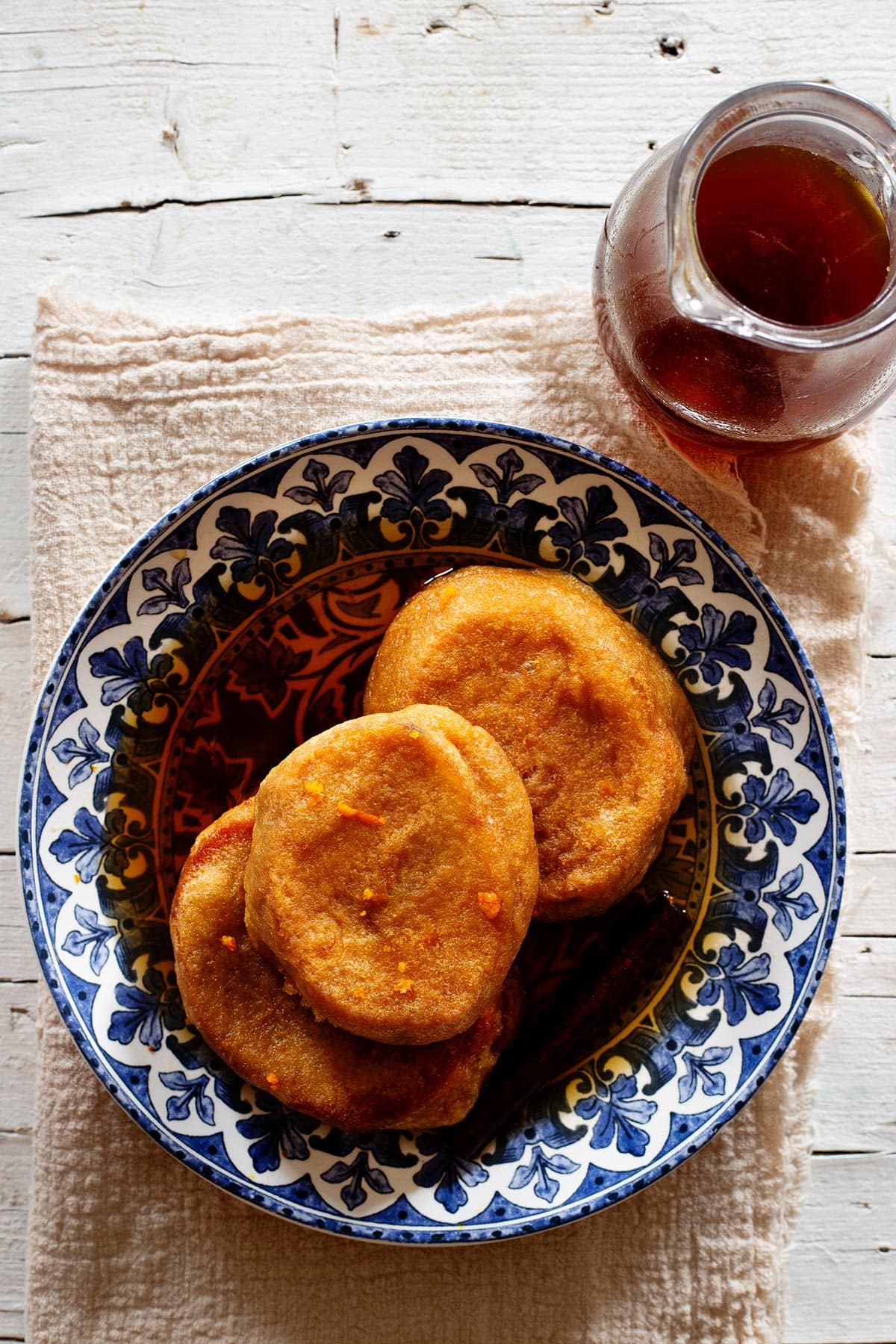
Ingredients
- Bread: Traditionally, torrejas are made with stale bread, preferably french bread or bolillos (Mexican-style bread rolls). The stale bread helps absorb the custard-like mixture without falling apart.
- Eggs: Eggs are beaten and used to coat the bread slices.
- Oil: Vegetable oil such as sunflower oil or corn oil is used for frying the torrejas until they turn golden brown and crispy on the outside.
- Piloncillo: This type of sugar is used to make the syrup, you can find this ingredient at any Mexican or Latin American grocery store or on Amazon.
- Spices & aromatics: To infuse the syrup you’ll need cinnamon sticks (canela), anise star, whole cloves, and orange peel.

How To Make Torrejas
Cut the bread into slices about 1 inch (2.5cm) thick. I used rolls that were about 6 inches/16cm large and ended with about 25 slices in total.

Place water in a large stockpot, add piloncillo, cinnamon sticks, orange peel, anise star, and whole cloves.
Bring to a boil over medium heat and cook for about 15 minutes or until a light syrup has formed.

Keep the piloncillo syrup warm until needed (leave it on the stove with the heat turned to the lowest).
Separate the whites and yolks, placing the whites in a large mixer bowl, and the yolks into a small bowl.
Add a pinch of salt to the egg whites and beat at high speed until soft peaks form.

Next, while beating at low speed, add one by one the egg yolks and beat until fully combined. Set aside.

Heat about 2 cups of oil in a deep pan. Prepare also a large plate lined with a couple of kitchen paper towels.
Take one slice of bread and dip it into the egg mixture making sure it coats evenly on all sides.

Carefully, add it to the frying pan. Repeat and add as many slices as fit on your pan but don’t overcrowd it.
TOP TIP: Fry the torrejas in batches, leaving enough space between each slice. Overcrowding the pan can lead to uneven cooking and prevent the bread from achieving a crisp and golden exterior.

Fry the bread on all sides until nicely browned, depending on the temperature, you might need from 30 to 40 seconds on each side.

As the fried bread slices come out of the pan, place them onto the paper-lined plate. Repeat until all bread and egg mixture are used.

Next, add all fried bread slices into the pot with the piloncillo syrup.
Make sure to push them gently to the bottom so they will soak all the flavorful mixture.

Allow torrejas de pan to rest for 10 minutes then serve on plates making sure to pour plenty of piloncillo syrup over.
Expert Notes
- Choose the right bread: It’s best to use slightly stale or day-old bread for this recipe. This helps the bread slices hold their shape and absorb the custard mixture without becoming too soggy. If you don’t have stale bread, just cut the slices and leave them on your kitchen countertop for a few hours before starting the recipe.
- Fry at the right temperature: Preheat your frying pan or skillet on medium heat and add enough oil to fry the bread slices. Make sure the oil is hot enough before adding the coated bread slices. Adjust the heat as needed to maintain a steady, even cooking temperature.
- Drain excess oil: After frying, place the fried bread slices on a paper towel-lined plate or wire rack to drain any excess oil. This helps remove any greasiness and keeps the bread crispy.
- Soak the fried bread nicely: Make sure to soak the bread slices in the syrup for a sufficient amount of time. This allows the bread to absorb all the amazing flavors!
Recipe Variations
This recipe has so many variations throughout Mexico. For example:
- In Chihuahua, they are made with sliced bread, egg, and piloncillo syrup, sprinkled with toasted sesame seeds. They also have an apple version with sliced apples, or made with pinole mixture, and a salty version with dried shrimp.
- In Comitán, Chiapas, they make them with loaf bread, milk, wine, egg, and honey.
- In Coahuila and Nuevo León, they’re made with buttered sliced white bread, piloncillo honey with anise, cinnamon, and clove.
- In Chilapa, Guerrero, they make them with sliced marquesote, a type of sweet cake, drenched in syrup that contains sugar, cinnamon, and brandy.
- In Zacatecas, they often serve them with agave syrup and sweet sherry wine during Christmas season.
- In Puebla, the bread is first soaked in a milk mixture then coated in egg, fried, and served with a light sugar syrup with rum. They are very popular along with gorditas de nata.
- In Yucatán, they are made with ripe plantain, which is pureed and mixed with corn dough and sugar. Then, they are shaped into cakes, fried, and served hot.
- In Tabasco, torrijas are made with yuca, a tuberous similar to sweet potatoes.

How To Store and Reheat
Before storing, allow the Mexican torrejas to cool down, place them in a container with all the piloncillo syrup, and close with an airtight lid. They store nicely from 4 to 5 days in the fridge.
To reheat, place the leftovers on a shallow pan over medium-low heat until nicely warmed. Or place the container in the microwave and heat everything in 30 seconds intervals.
FAQ
What is the difference between torrijas and french toast?
Torrijas have their roots in Spain and are particularly associated with the Easter season and traditional Spanish cuisine. They are commonly consumed in Spain and other Spanish-speaking countries. French toast, as the name suggests, is associated with French cuisine and is popular worldwide.
What are torrejas in English?
In English, the term “torrejas” is typically translated as “Spanish-style French toast”. While the term itself can be used in English, using the additional description helps provide context and convey the specific style and origin of the dish.
What is the origin of the torrejas?
The origin of torrejas can be traced back to ancient Roman cuisine. The Romans had a dish called aliter dulcia, which involved soaking bread in a mixture of milk and eggs and then frying it. They were introduced to Spain during the period of Moorish rule. Over time, the dish evolved and became an integral part of Spanish cuisine, especially during the Lenten season.
Later, the recipe spread to the Spanish colonies during the colonial era, including Latin America, where they became popular and adopted regional variations.
More Mexican Desserts
Have you tried this Mexican dessert recipe? Leave a comment below to let us know how it turned out! Also, don’t miss out on our latest blog posts! Follow us on Instagram, Facebook, Pinterest, and YouTube.
Print Recipe
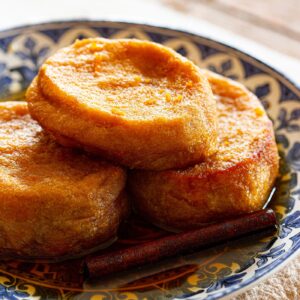
Torrejas (Mexican French Toast)
Ingredients
- 4 medium bolillos
- 4 medium eggs
- 1 pinch salt
- oil for frying
For the piloncillo syrup
- 1.1 lb piloncillo or brown sugar
- 2 small cinnamon sticks
- 1 orange peel
- 1 anise star
- 3 whole cloves
- 6 cups water
Instructions
- Cut the bread into slices about 1 inch/2.5cm thick (read note 2).
- Place water in a large stockpot, add piloncillo, cinnamon sticks, orange peel, anise star, and whole cloves.
- Bring to a boil over medium heat and cook for about 15 minutes or until a light syrup has formed.
- Keep the piloncillo syrup warm until needed.
- Separate the whites and yolks.
- Place whites in a mixer bowl add a pinch of salt and beat at high speed until soft peaks form.
- While beating at low speed, add one by one the egg yolks and beat until fully combined. Set aside.
- Heat about 1 1/2 cups of oil in a deep pan. Prepare also a large plate lined with a couple of kitchen paper towels.
- Take one slice of bread and dip it into the egg mixture making sure it coats on all sides.
- Carefully, add it to the frying pan.
- Repeat and add as many slices as fit on your pan but don’t overcrowd it.
- Fry the bread on all sides until nicely browned, depending on the temperature, you might need from 30 to 40 seconds on each side.
- As the fried bread slices come out of the pan, place them onto the paper-lined plate.
- Repeat until all bread and egg mixture are used.
- Add all fried bread slices into the pot with the piloncillo syrup. Make sure to push them gently to the bottom so they will soak well.
- Leave to rest for 10 minutes then serve on plates with plenty of piloncillo syrup over.
Notes
- Bolillo rolls are the perfect option for this recipe but of course, if you don’t have it available at your nearest supermarket or don’t want to make your own, just go with french bread or baguette.
- Depending on the type of bread you use, your slices might be smaller or larger, just make sure to cut them 1 inch/2.5cm thicker as the recipe calls. I got about 25 slices in total.
- Nutritional info includes approximately 1/2 cup oil for frying.



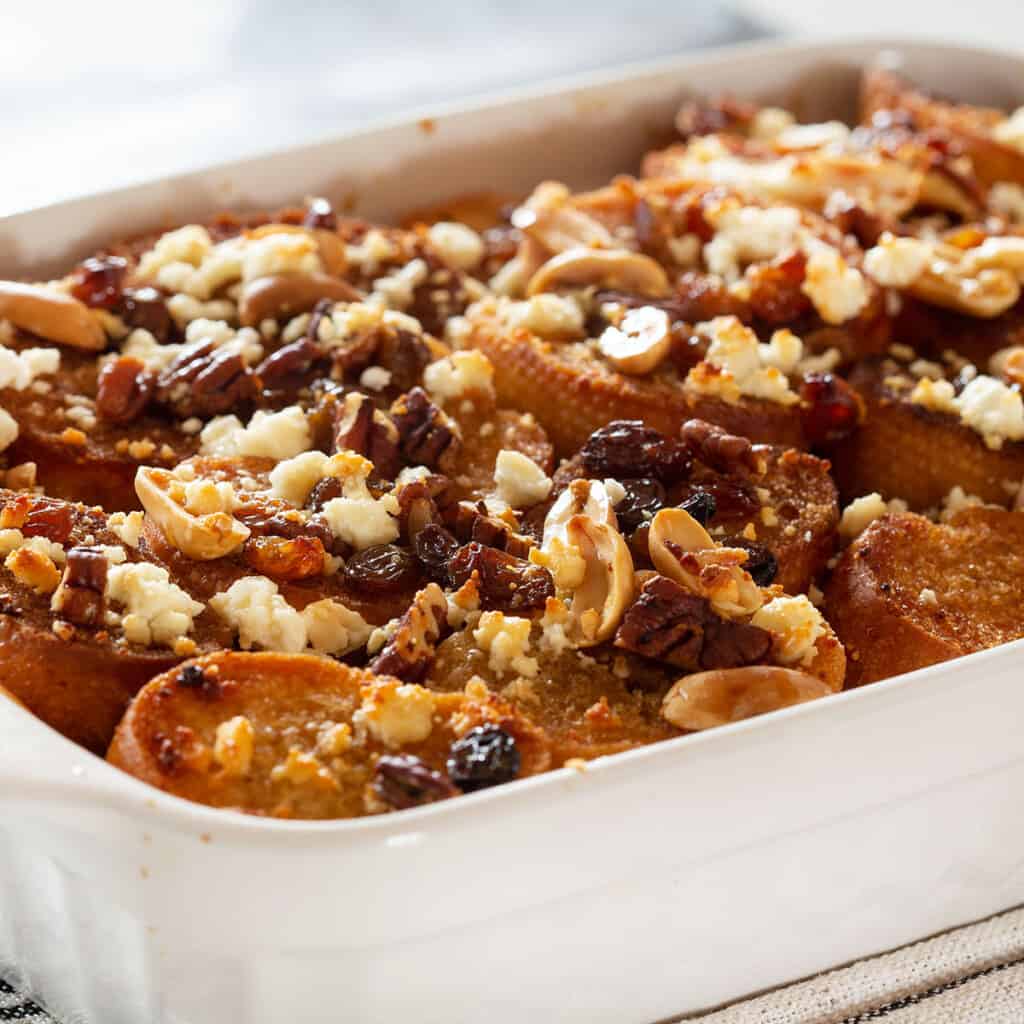
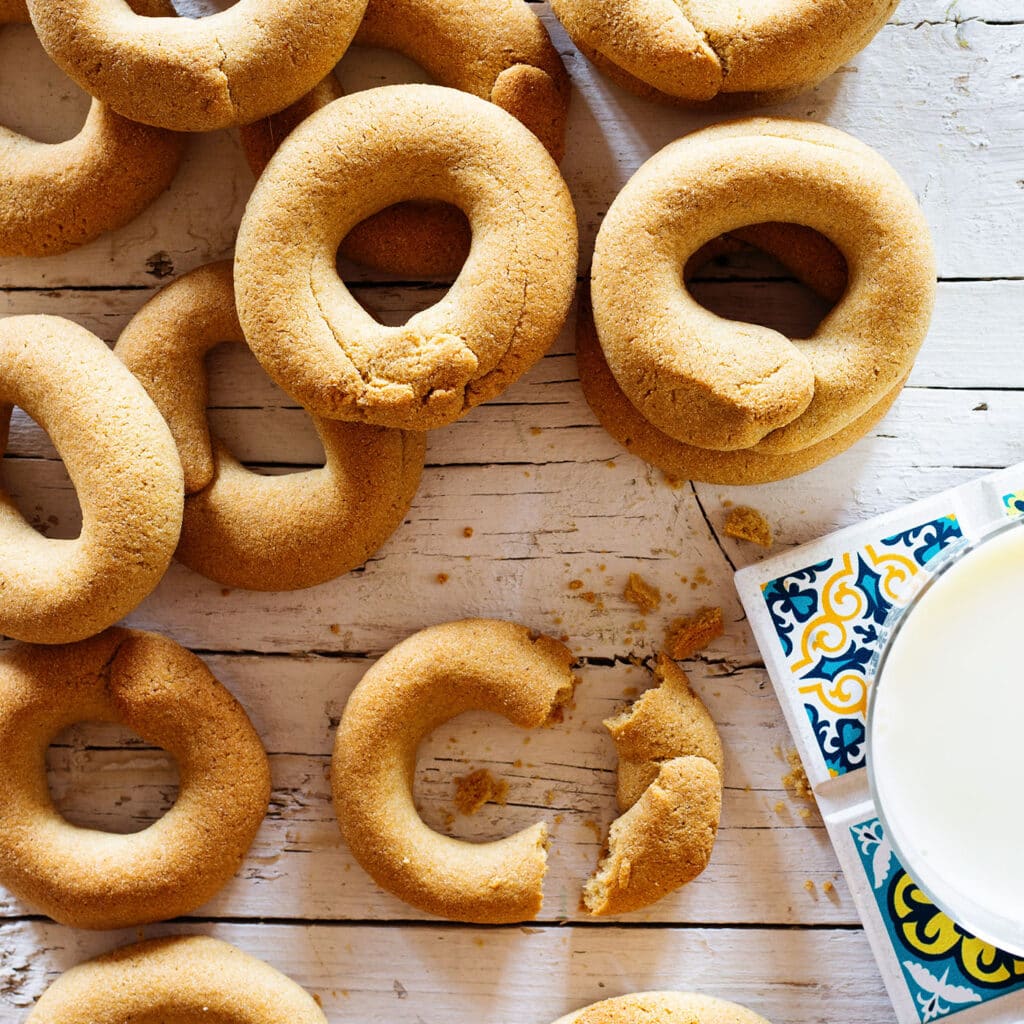
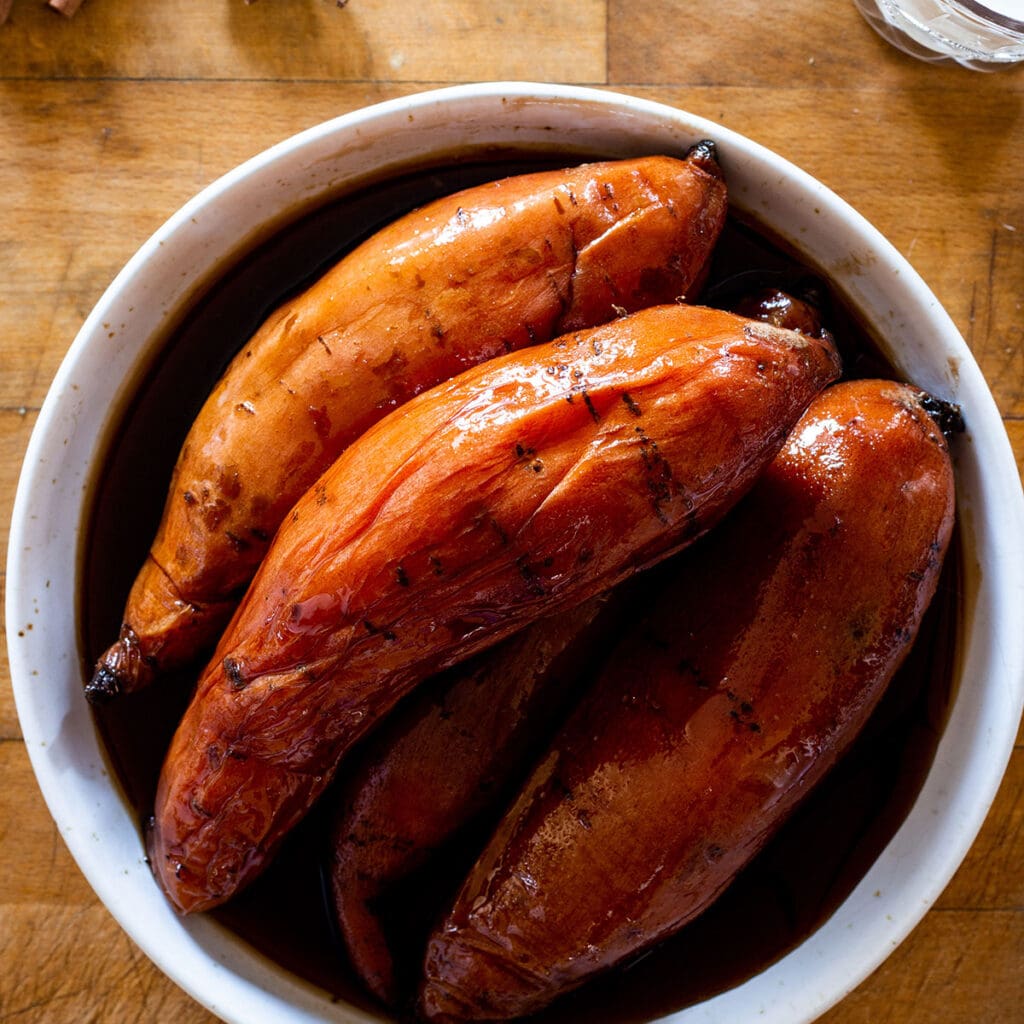
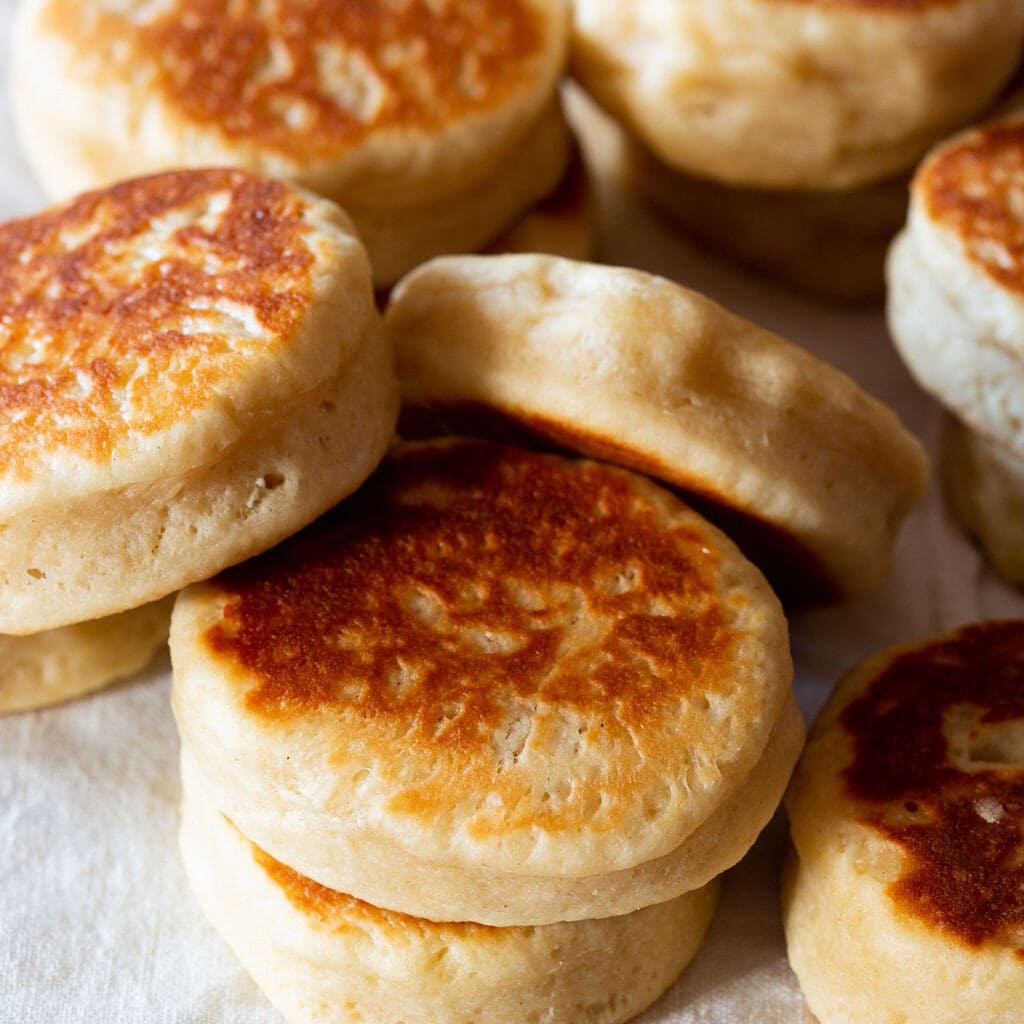
Even though is not cuaresma, I still made your recipe because I was craving torrejas soo much haha! they were delicious and reminded me so much of my lovely abuela. Thanks!
I loved the torrejas, my husband not too much, he said they were overly sweet. But np, more for me haha